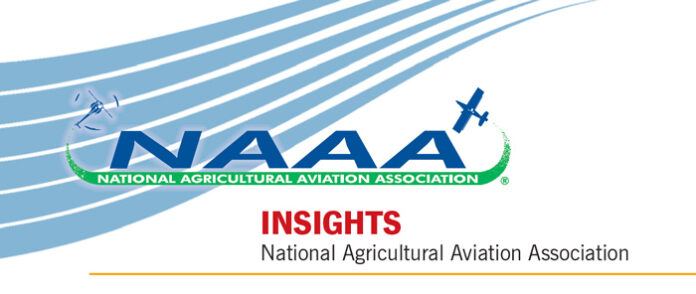Collect data now for submission this fall
Mississippi State University’s Raspet Flight Research Laboratory is continuing its research study on safe operational distances between low-altitude, manned aircraft and drones. MSU Raspet is now beginning the second stage of GPS flight log data collection from manned agricultural aircraft. Many AgAir Update readers may have donated GPS flight log data during the first stage of data collection from 2017 to 2020. This second stage of GPS flight log data collection is critical to continue MSU Raspet’s ongoing research. Methods for GPS flight log data deliveries remain the same as the first stage.
This effort is supported and encouraged by the National Agricultural Aviation Association (NAAA) because MSU Raspet’s objective is to understand, model and predict manned ag aircraft in order to educate drone operators and promote safe, responsible drone flight in ag environments. Madison Dixon, the MSU aviation program manager, reported on the progress of the first study at the 2020 Ag Aviation Expo. Over a period spanning three years, NAAA members donated 49,180 flight logs in 20 different states. Some information calculated from the data includes an average ag aircraft application speed of 139 mph and an average ferrying speed of 132.8 mph.
More GPS flight log data is needed for the next research steps to facilitate the safe integration of unmanned aircraft into the airspace in which manned ag aircraft operations occupy. The data collected could have other benefits to ag aviation safety and performance such as average turn radius, decent and ascent angles, etc.
As with the first stage of data collection, NAAA and MSU Raspet agreed that all of the information collected is confidential, as confirmed from this language from MSU Raspet:
*IMPORTANT* Just as with our previous GPS flight log data collection effort, please know that MSU remains fully committed to protecting the privacy of NAAA’s members who donate their flight logs. The personal information of NAAA members who choose to donate their data will NOT under any circumstances be shared outside MSU. Furthermore, the GPS flight logs themselves will be stripped of all personally identifying information before any research is conducted using the data. Our research would never be possible without these data donations from NAAA membership. We tremendously value and appreciate your NAAA members who trust us with their data. At the end of the day, the privacy and security of these members is our utmost priority.
Please begin collecting your data now. NAAA and MSU plan to make it easier to transfer it to Raspet, or if you have data from last season that you can transfer now, the steps to do so are accessible using the link and login credentials below:
- Upload to NAAA Ag Data Repository following website, username and password (1 GB file limit per upload): https://www.hpc.msstate.edu/raspet-naaa/
Username: raspet-naaa
Password: Ag2!naaArePo - Upload to a secure Dropbox link (available upon request to Madison Dixon, MSU Aviation Program Manager, at mpd162@msstate.edu) for large uploads.
- Email to Madison Dixon, MSU Aviation Program Manager, at mpd162@msstate.edu.
- Mail a flash-drive or other external hard-drive device to the address below (The flash-drive will be immediately mailed back to the sender once data is received):
Attn: Madison Dixon
MSU Raspet Flight Lab
114 Airport Road
Starkville, MS 39759
New with the second stage of data collection is the need to capture aircraft make and model info (not the N number or other personal identifying information) and GPS system make and model info in addition to the GPS flight logs. These additional details will make the research more useful, as the airspace modeling will be impacted by different aircraft, such as fixed-wing versus helicopter operations. If you choose to make a GPS flight log data donation, please try to include these aircraft and GPS details with your donation. The overall objectives of the research remain the same:
- Identify Ag Aircraft Operational Trends
- Develop Ag Aircraft Operational Model
- Validate Model through Observation/Collection of Empirical Data
- Inform / Educate UAS operators
- Promote Safety in all Low-Altitude Ag Environments





